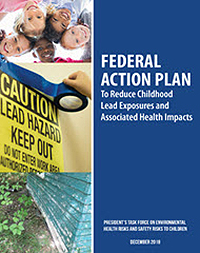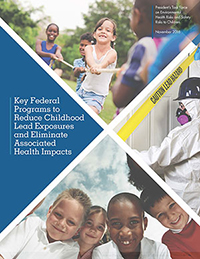Leadership
Warren Friedman, Ph.D., FAIHA
Senior Advisor
Office of Lead Hazard Control and Healthy Homes
U.S. Department of Housing and Urban Development
Maureen R. Gwinn, Ph.D.
Acting Assistant Administrator
Office of Research and Development
U.S. Environmental Protection Agency
Erik Svendsen, M.S., Ph.D.
Director, Division of Environmental Health Science and Practice
National Center for Environmental Health
Centers for Disease Control and Prevention
Purpose
The Lead Exposures Subcommittee coordinates the Task Force’s interagency efforts to better understand and prevent childhood exposure to lead and associated disease and disabilities from lead exposures, supporting commitments of the 2018 Federal Lead Action Plan.
There are no safe levels of lead in the blood. Due to significant federal regulatory action. the United States has made tremendous progress in reducing lead exposure, resulting in a 94.5% decline in childhood blood lead levels (BLLs) between 1976 and 2016. Despite this decline, lead exposure remains a significant health concern for children, causing serious neurological, cognitive, and other effects. The effects of lead poisoning can be permanent.
Today, about 3.3 million U.S. families with a child under age 6 live in a home with building components, such as walls, windows, doors, stairs, railings, and porches that contain lead-based paint. Children can be exposed to dangerous levels of lead when this paint chips or flakes off and is breathed in or eaten. Additional exposure sources include water from lead pipes, contaminated soils, and some imported products, such as food, toys, cosmetics, and jewelry. Certain jobs and hobbies may also be sources of childhood exposure. CDC uses a blood lead reference value (reference value), currently 3.5 micrograms per deciliter (µg/dL) for children under age 6 to help identify children with BLLs higher than most children's levels. There are about 500,000 children in the United States with BLLs at or above the reference value.
The goals of this subcommittee include:
- Recommend to the President’s Task Force coordinated federal strategies to prevent childhood lead exposures and associated harmful effects
- Disseminate information on lead exposure and its effects to a range of audiences, including policy makers, healthcare providers, the general public and other stakeholders
- Coordinate and disseminate an inventory of federal actions to reduce childhood lead exposures
Activities
The Lead Exposures Subcommittee is helping to coordinate across federal agencies as they work to implement the goals of the Federal Action Plan to Reduce Childhood Lead Exposures and Associated Health Impacts.
Resources
- About Childhood Lead Poisoning Prevention
- Children's Health Exposure Analysis Resources
- Consumer Tool for Identifying Point-of-Use and Pitcher Filters Certified to Reduce Lead in Drinking Water
- Eliminating Childhood Lead Poisoning: A Federal Strategy Targeting Lead Paint Hazards
- EPA Environmental Topics: Lead
- Federal Action Plan to Reduce Childhood Lead Exposures
- Funding Sources to Address Lead in Water
- If You Work Around Lead, Don't Take It Home!
- Key Federal Programs to Reduce Childhood Lead Exposures (14MB)
- Kids Environment Kids Health: Lead Poisoning
- Lead Exposure and Prevention Advisory Committee (LEPAC)
- NIEHS Environmental Health Topics: Lead
- NTP Monograph: Health Effects of Low-Level Lead
- Office of Lead Hazard Control and Healthy Homes
- Strategy Resources to Support Access to Safe and Healthy Early Care and Education Facilities
Accomplishments
2024 Progress Report on the Federal Action Plan to Reduce Childhood Lead Exposures and Associated Health Impacts
The 2024 Progress Report on the Federal Action Plan to Reduce Childhood Lead Exposures and Associated Health Impacts is the first published update on advancements made through the plan during 2018-2024 to protect children's health. It includes a list of federal efforts to reduce childhood lead exposures and mitigate related health impacts. The report details actions such as efforts to reduce exposures to lead in paint, dust, drinking waler, soil, food, consumer products, and air pollution. This report describes research to develop a set of models that simulate human exposures to lead from multiple environmental sources and estimate blood lead concentrations at local and national scales. It also describes efforts to improve screening for developmental delays in lead exposed children and to increase awareness of lead hazards and actions that can be taken to protect against exposures.
Learn more in the downloadable report:
Plan to Reduce Childhood Lead Exposures and Associated Health Impacts
The Federal Lead Action Plan is aimed at reducing lead exposure through collaboration in the federal government and with a range of stakeholders, including states, Tribes, and local communities, along with businesses (for-profit and nonprofit), property owners, and parents. The Action Plan helps the federal government work strategically and collaboratively to reduce exposure to lead and improve children's health.
Learn more in the downloadable report:
Lead Action Plan (8MB)
Key Federal Program to Reduce Childhood Lead Exposures and Eliminate Associated Health Impacts
This report of the President's Task Force catalogs federal efforts to understand, prevent, and reduce various sources of lead exposure among children. The report provides a starting point for a comprehensive federal lead strategy and will enable increased coordination and collaboration among federal agencies to further protect the nation's children.
Learn more in the downloadable report:
Key Federal Programs (14MB)
Eliminating Childhood Lead Poisoning: A Federal Strategy Targeting Lead Paint Hazards
In 2000, the Task Force released a set of recommendations aimed at eliminating childhood lead poisoning in the United States. The report focuses primarily on expanding efforts to correct lead paint hazards (especially in low-income housing), a major source of lead exposure for children.



